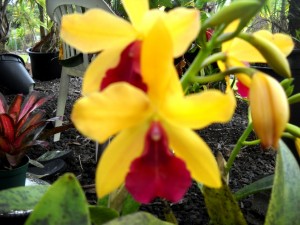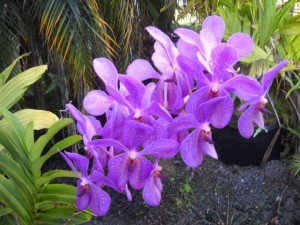Types of Orchids
 There are thousands of different kinds of orchids. In fact, there are over 22 thousand different species of orchids in the world today and many more are still being discovered. But all orchid plants fall into 880 genera or categories. The ten most popular types of orchids are: Cattleya, Phalaenopsis, Vanda, Dendrobium, Paphiopedilum, Oncidium, Miltonia, Phragmipedium, Odontoglossum and Cymbidium orchids.
There are thousands of different kinds of orchids. In fact, there are over 22 thousand different species of orchids in the world today and many more are still being discovered. But all orchid plants fall into 880 genera or categories. The ten most popular types of orchids are: Cattleya, Phalaenopsis, Vanda, Dendrobium, Paphiopedilum, Oncidium, Miltonia, Phragmipedium, Odontoglossum and Cymbidium orchids.
Though my primary focus is anthuriums, I have been known to grow a few orchids from time to time. But I am by no means an expert on orchids. There are so many different species of orchids that I don’t think anyone can be an expert on all of them. I think that true orchid experts tend to specialize on single family of orchids in order to gain deep rather than wide knowledge of these amazing plants.
Phalaenopsis Orchids
Phalaenopsis are also called Moth orchids. They are great orchids for people who are new to growing orchids because they are some of the toughest orchids around. Some orchids are a little on the weak side, but Moth orchids are tougher and they are more tolerant of small mistakes in care.
Vanda Orchids
Vandas are true to their epiphytic nature. They prefer growing free attached to trees rather than having their roots all cramped up in a pot. They seem to like it when their roots can breathe a little oxygen. So grow them on a tree or in a hanging basket if at all possible. Save your bench space for other plants that need it more.
Cattleya Orchids
 Did you know that there are 113 species of Cattleya Orchids?
Did you know that there are 113 species of Cattleya Orchids?
Well that is what you will find, and they all come from South America. They are named for a man named Sir William Cattley who was the very first individual to grow them outside of their native habitat. These lovely orchids generate large, sophisticated flowers and they are a favorite of orchid breeders. Sometimes they can produce flowers which are six inches across.
They come in almost every color imaginable except for the two colors which you by no means wish to see on your skin, black and blue, unless you are wearing these colors.
They have an interesting structure. The number 3 plays a really important function in their composition. They have three narrow petals and 3 broad petals, but one of their broad petals forms what may look like their mouth. But in contrast to us, they don’t use their mouth to eat, it’s just for show.
Cymbidium Orchids
Cymbidium orchids are also referred to as boat orchids. Why? It’s because they look like boats. Not… Actually I don’t have a clue why they are called this.
There is exactly 52 species of cymbidium orchids. This is a fascinating quantity because this is the same quantity of cards which you will find inside a deck of playing cards. All of these species originated in Asia and a few of the bigger species are able to live at high altitudes.
Cymbidiums have a tendency to produce flowers that are slightly smaller than Cattleyas. In fact, their largest flowers have a tendency to be only four inches across. But they do produce a great quantity of flowers. The majority of the time they will generate a minimum of ten flowers or much more.
They’re a better variety for those of you who live in colder climates. They cannot survive freezing temperatures, but they are able to common deal with temperatures down to 45 degrees. Though, we would struggle to locate those temperatures here in Hawaii.
Dendrobium Orchids
Would you believe that dendrobiums are one of the most plentiful species of orchids?
There are roughly 1,200 species of dendrobiums in the planet these days. These stunning orchids original come from Oceania, which is the region encompassing Asia and Australia. Having a family as large as they have, isn’t it apparent that they would need to come from a large part of the globe?
Another fascinating factoid is that their name derives from the Greek words for tree and for life. They are essentially tree-life or plants that prefer to live on trees. The technical term for this really is epiphytes.
Since they come from such a large region, various species of dendrobiums are adapted to various climatic extremes. Some species prefer to develop in dry locations like the deserts of Australia, while other species like the high altitude cold weather from the Himalayas.
Dendrobiums tend to generate little flowers, but they can generate a lot of them. Some plants can produce up to 100 flowers at a time. Like bears they prefer to sleep in the winter time and do the majority of their growing within the summertime. But, in Hawaii, we tend to have endless summers, so they have a really lengthy growing season here.
Miltonia Orchids
Miltonias were discovered by John Lindley in 1837 in the Brazilian Atlantic Forest. They produce large flowers which last a long time on the plant, but not so long when used as a cut flower. They derive their name from Lord Milton who was an early English orchid fanatic. Miltonia are generally medium to large orchid plants and they also produce medium to large orchid flowers from 4 to 15 centimeters wide.
Finally, I realize that I haven’t covered Odontoglossum, Oncidium, Paphiopedilum and Phragmipedium orchids, yet. But don’t worry. I’ll get to them eventually.
Amazon Bestsellers: Orchid Plants and Books

